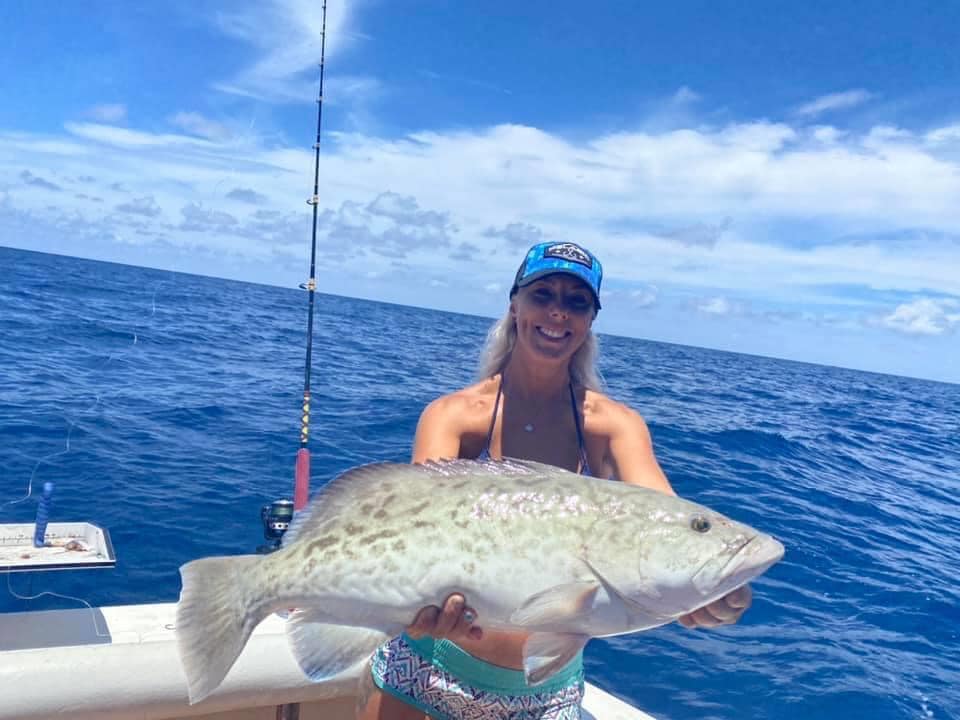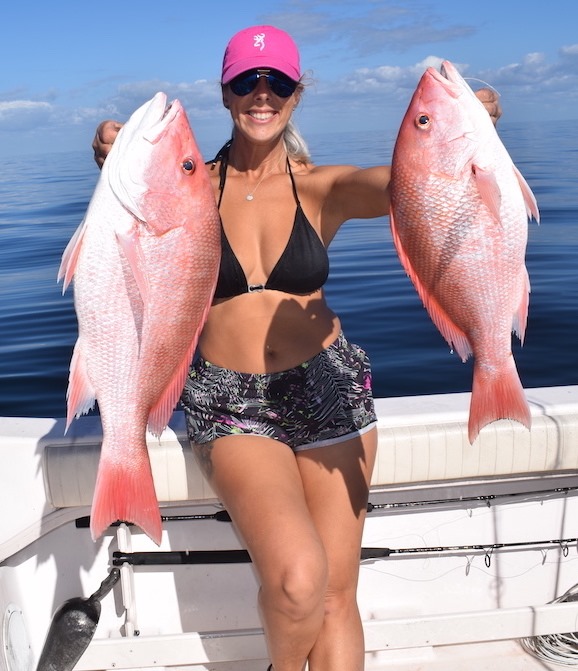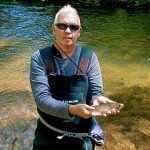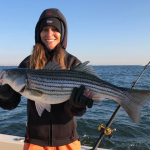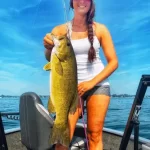11 Productive Florida Offshore Fishing Tips
This article will list 11 productive Florida offshore fishing tips that will help anglers be successful in the open Atlantic Ocean or Gulf of Mexico. The state of Florida offers anglers some incredible offshore fishing opportunities!
There are two distinct techniques that are used when fishing the offshore waters of Florida; trolling and bottom fishing. While some game fish can be caught using both techniques, generally speaking, each technique targets different species. Billfish, wahoo, king and Spanish mackerel, tuna, dolphin, and barracuda are most often caught while trolling. Grouper, snapper, amberjack, triggerfish, grunts, and other species are caught by anglers bottom fishing in Florida.
11 Useful Florida offshore fishing tips
- Spinning tackle has a place in Florida offshore fishing
- Conventional tackle is best for Florida offshore fishing
- Offshore bottom fishing rigs include sliding sinker, chicken, and knocker rigs
- Circle hooks are best for bottom fishing offshore
- Florida bottom fishing baits vary
- Proper boat positioning is critical to success
- Don’t set the hook when bottom fishing offshore
- Trolling with plugs is productive when offshore fishing in Florida
- Trolling with spoons is best for king and Spanish mackerel.
- Planers are effective for offshore trolling
- Trolling with live bait offshore in Florida produces trophy fish
Tackle for offshore fishing in Florida
Offshore fishing tackle can run the gamut. Light spinning tackle is the best choice for yellowtail snapper and other small bottom fish. 80 pound conventional gear is required to winch up a large grouper from a deep water wreck. Trolling for bill fish requires fairly expensive conventional outfits. Therefore, anglers offshore fishing in Florida will need several outfits in order to be successful.
1) Spinning tackle has a place fishing offshore in Florida
The same spinning tackle used to target snook and redfish in the inshore waters will work fine on the shallow reefs and wrecks in water less than 40 feet deep. A 7 foot medium action spinning rod with a 2500-3000 series reel and 20 pound braid or 12 pound monofilament line will work well. The same rig works fine if a school of smaller fish such as Spanish mackerel or peanut dolphin are located working on the surface.
Anglers can shop at Amazon for a Daiwa Black Gold reel and St Croix Triumph 7′ MF rod spinning combo in this link.
“Fishing Lido Key is a participant in the Amazon Associates Program, an affiliate advertising program designed to provide a means for sites to earn advertising fees by advertising and linking to Amazon. As an Amazon Associate I earn from qualifying purchases. ”
Anglers should also keep a heavier spinning outfit on board. A 7 foot medium heavy spinning rod with a 5000 series reel spooled with 40 pound braid or 20 pound monofilament line is a good all-around rig. It can be used to free lined baits for sailfish and cobia as well as heavier bottom fishing for anglers who prefer spinning tackle. Here is a link to a Penn Battle combo that works well for offshore fishing. Click on the link to shop.
2) Conventional tackle is best for fishing offshore in Florida
Conventional tackle is best suited for most offshore fishing situations. In most offshore fishing, casting is not required. Therefore, the strength of conventional tackle really shines. Conventional reels are basically winches, as opposed to spinning reels where the line turns 90° at the spool. Conventional reels have more power and better drags then do spinning reels. They also hold a lot of line.
Light Tackle Trolling in Saltwater video
Anglers will need several different conventional outfits to cover the various fishing situations. A light conventional outfit with a 7 foot to 7 1/2 foot rod and matching real works great for light tackle bottom fishing as well as trolling for smaller species such as Spanish mackerel and smaller tuna and dolphin.
Several larger conventional outfits will be required as well. Anglers will find medium conventional rigs in the 40 pound class to be very versatile. They work well when bottom fishing for larger fish in deeper water as well as when trolling large plugs and planers for king mackerel and other species. Finally, a heavier rig in the 6/0 class can be used when targeting larger game fish as well as for trolling large planers. It can also be used for bottom fishing for very large fish. Here are some recommendations for Penn outfits at an affordable price. Clink on the links to shop.
Florida offshore fishing tips; bottom fishing
Bottom fishing is a very basic technique, perhaps the first one ever used to catch a fish. In it simplest form, it is baiting a hook and dropping it to the bottom. However, there are many nuances and tactics that spell the difference between success and failure when bottom fishing.
There are several different rigs that are commonly used when bottom fishing in Florida. One of the easiest to use and effective rigs is a sliding sinker rig, also known as a “Carolina rig” in some areas. It consists of an egg shaped sinker with a hole through the center. The running line passes through this hole and then a swivel is attached. A leader is attached to the other end of the swivel followed by the hook.
Offshore Fishing Tutorial for Beginners video
Leader lengths and strengths vary depending on water depth and species being targeted. Anglers fishing in shallow water will do fine with a 30 pound test fluorocarbon leader of around 3 foot in length. Anglers fishing deep water wrecks and reefs for grouper and snapper will often times use leaders as long as 20 feet and up to 100 pound test fluorocarbon.
3) Offshore bottom fishing rigs include sliding sinker, chicken, and knocker rigs
One variation of this rig is called a ”knocker rig”. With this rig the sinker is placed between the swivel and the hook. This allows the weight to ride right on the eye of the hook. It may look a bit odd, but is very effective. The advantages this rig has is that when the weight is on the bottom, the bait is on the bottom. Also, the weight sliding against the hook I can help dislodge it if it gets snagged. This is how it earned its name.

Another popular and effective rig is called the “spreader rig” or “chicken rig”. It consists of a swivel at the top, a sinker at the bottom, and multiple hooks tied at intervals. This is a great rig to use when drifting in open water. It also has the benefit of presenting multiple baits at various distances off the bottom. A bank sinker is normally used with this rig.
The general rule regarding sinker weight is to use the minimum amount of weight required to return hold bottom. The less weight used the better in most applications. That will result in a more natural presentation as the bait slowly flutters down versus rocketing down to the bottom and making a loud noise.
4) Circle hooks are best for bottom fishing offshore
Hooks are the final component in the rig. There are endless choices when it comes to hook sizes and styles. Anglers fishing the Gulf of Mexico are required to use circle hooks. These hooks have been proven to reduce gut hooking and thus mortality in fish that are to be released. While anglers fishing the Atlantic Ocean are not required to use them, many do for the same reason.
Hook size should be matched to the size of the bait being used, not the size of the fish being targeted. A very large fish can be caught on a small hook when the drag is set correctly. Anglers fishing for small snapper in shallow water will use a hook a small as a #4. Bottom fishing for large grouper and amberjack require the use of a hook as large as a #10/0.
5) Florida bottom fishing baits vary
Baits used when bottom fishing in Florida vary by location and season. Shrimp, either live or frozen, are an excellent bait when fishing shallow water reefs all season long. They produce snapper, grouper, sheepshead, triggerfish, porgy, flounder, and just about every fish that swims. They are easily obtained at just about every Florida bait shop. Live shrimp can be hooked through the horn while frozen shrimp are usually threaded on.
The vast majority of bottom fishing in Florida is done using either live or cut up fish. The reason is simple, big fish feed on little fish. Frozen baits such as Spanish sardines, mullet, false albacore, menhaden, and other fish work well. Again, baits will vary by location. Frozen squid is another universal and effective bait that will catch a variety of species.
Many serious offshore anglers prefer using live baits. Pin fish and grunts can be purchased at some bait shops. Special traps can be used on the shallow grass flats to catch them as well. Many offshore trips begin with the catching of bait at buoys and hard bottom areas close to shore. Anglers use a Sabiki rig (a special rig that uses a half dozen flies) or small baited hooks to fill up the bait well. Cast nets can also be used to procure pilchards on the flats or other bait fish close to shore.
Florida bottom fishing structure
There are several types of structure that will hold bottom fish in Florida. These include natural ledges, artificial reefs, wrecks, and areas of hard bottom. Generally speaking, bottom fish will hold to some type of structure. Rarely will they be found in open water on sandy bottom. While there are many artificial reefs and ledges where the locations are public, putting in time and finding “private”little spots will result in more fish being caught.
Boat positioning is crucial when it comes to bottom fishing. Most anglers like to place the stern of the boat upwind and up tide of the spot being fished when possible. This results in a natural presentation as the bait eases back towards the structure with the tide. Also, luring the fish out of its structure will result in a better chance of landing versus being cut off on the bottom.
6) Proper boat positioning is critical to success
Anchoring correctly is an art that only experience will teach. The general approach is to put the bow of the boat into the wind and tide, drive over the spot, the drop the anchor and drift back. Hopefully, the boat will be in the right position. Once the boat settles on the anchor, it is best to look at the heading on the compass. Unless the current or when changes, this compass heading should work on the next drop.
GPS trolling motors have revolutionized bottom fishing for anglers using bay boats. When conditions are calm, the angler uses the “anchor” or “spot lock” feature to keep the boat in perfect position. This works extremely well and eliminates the need for heavy anchor equipment.
Once the boat is in the desired location, it is time to fish! Regardless of the depth, the technique is basically the same. Hooks are baited and dropped to the bottom. Rod tips are held low close to the water surface. Some fish will tap the bait several times, while others will simply inhale it. In either event, once a steady weight is felt the angler reels fast and hard to eliminate any slack in the line than the rod tip is lifted up.
7) Don’t set the hook when bottom fishing offshore!
This technique of reeling and lifting works much better when bottom fishing than setting the hook. This is especially important when using circle hooks. A steady pull will result in the hook ending up in the corner of the mouth. The first few seconds of the fight are crucial as the angler tries to get the fish a few feet away from the structure. Once accomplished, the angler can take his time and work the fish to the surface.
Many anglers use chum when bottom fishing in Florida. This can be an extremely effective technique to get the bite going. Chum is considered essential when targeting yellowtail snapper. Frozen chum is most often used as it is easy and convenient. A block of chum is placed in a mesh bag either at the surface or can also be lower to the bottom. As the block melts, the chum disperses in the water attracting bait fish and game fish.
It is important not to overdo the chum. The idea is to attract and excite the fish, not to fill them up. Anglers can also cut up small pieces of the same bait being used on hooks to attract fish. Spanish sardines are especially effective. It is a good idea to keep a spinning outfit rigged and ready in the event that fish show up at the surface in the chum. A hook with no weight can be baited and free lined out and will usually draw a strike.
Florida bottom fishing regulations
Anglers bottom fishing in Florida will catch a wide variety of species. Several different species of grouper will be caught including red grouper, gag grouper, black grouper, scamp, goliath grouper, and more. Snappers are just as varied with red snapper, mangrove snapper, yellowtail snapper, and mutton snapper being the predominant species. In addition, cobia, triggerfish, porgy, sheepshead, amberjack, and other species will also be taken.
It is very important to be able to identify the species that is landed and to know the current Florida fishing regulations. Seasons, sizes, and bag limits are constantly changing as Florida does its best to manage the resource. It is up to the angler to stay up to date on these regulations which also include tackle requirements and fish releasing procedures. All of this information can be found on the FWC web site.
Offshore fishing tips in Florida; trolling
Trolling is simply driving around while dragging lures or baits behind the boat and waiting for fish to strike. However, as with bottom fishing, it is not nearly that simple. Speed, depth, lures used, and locations all play a part in whether an angler is successful when trolling in Florida.
Most anglers that troll use artificial lures. Artificial baits can be trolled fairly quickly, allowing anglers to cover a lot of water in search of fish. Anglers targeting wahoo often troll as fast as 20 knots! Skirted baits, spoons, and plugs are the most commonly used artificial lures.
8) Trolling with plugs is productive when offshore in Florida
Plugs are very effective and productive lures to use when trolling offshore in Florida. Plugs have a lip on them which to a great degree determines the depth that they will dive when being trolled. Other factors such as line diameter and speed will also affect the depth, but the lip on the plug is the primary factor.
This is advantageous in that it allows anglers to cover a certain depth without the use of other devices such as weights and planers. The plug is simply attached to the leader and then it is ready to be deployed. In many applications a 6 foot long 80 pound test fluorocarbon leader works well. Anglers targeting toothy species, particularly king mackerel, will often use a wire leader or a short piece of wire in front of the plug.
Read more about trolling in saltwater in this article by Capt Jim
Most plug manufacturers will let anglers know the depths that the plugs are designed to run. Often times, these specs can be a tad optimistic. However, they are a good guide. Plugs work very well in open water for king mackerel, cobia, false albacore, blackfin tuna, barracuda, dolphin, and other species.
Trolling with plugs produces grouper
Deep diving plugs are deadly in shallow water when targeting grouper. This is particularly true in the Gulf of Mexico where the water gradually gets deeper the further and angler gets out from shore. The Gulf is littered with rocky ledges and hard bottom areas in depths between 30 feet and 60 feet. The Mann Stretch 30 plug was one of the first lures used for this technique.
In the cooler months gag grouper move into the shallower areas. They are very aggressive and will attack these plugs with gusto. Anglers simply tie the lures on 40 to 50 pound class conventional outfits and troll around at 4 kn or so. This is also a terrific way to locate other bottom fishing spots.
9) Trolling with spoons is best for king and Spanish mackerel
Spoons are very effective lures for anglers trolling in Florida. Trolling spoons are designed a bit differently than casting spoons. They are long and slender and have an outstanding action when pulled through the water. They work best at trolling speeds of 5 kn to 8 kn. Most are silver in color and imitate bait fish. Many come with a brightly colored prism finish to add flash.
As with all artificial lure fishing, the spoon should be matched to the size of the available forage and not the size of the fish being targeted. Spoons come in quite a few different sizes and angler should stock up on all of them in order to “match the hatch”. Generally speaking, smaller spoons do well on Spanish mackerel and false albacore while larger spoons are better for king mackerel.
Trolling spoons are fairly light and do require some device to get them down in the water column. Anglers have two choices in this regard, trolling sinkers and planers. Trolling sinkers are easier but will limit the depth that the spoon will dive. Planers are more involved, however will take a spoon down as deep as 30 feet.
Trolling sinkers
Trolling sinkers are simply weights that are designed to be trolled. The two basic types are keel sinkers and torpedo sinkers. Both work basically the same. The sinker is tied to the end of the running line. Then, a leader, usually around 10 feet long, is tied to the other end of the sinker. A spoon completes the rig. 30 pound test leaders work well with smaller spoons while 50 pound test leaders are better for the larger spoons.
Trolling sinkers are effective but will only get the spoon down in the water column several feet. The good news is that this is often ideal as many pelagic species feed very close to the surface. Once a fish is hooked, it is reeled and until the sinker is a foot or so from the rod tip. Then, the fishes hand lined in the rest of the way.
10) Planers are effective for trolling offshore
Planers are a bit more cumbersome but will get the spoon much deeper in the water column. They allow anglers to troll spoons at a brisk pace. Planers are ingenious devices that use the tension of the water to dive down to a certain depth. They have a sliding ring that once a fish strikes allows the planer to “trip”. This then allows the angler to fight the fish without the drag of the planer.
Planers come in sizes. The larger the number, the deeper the planer will dive. #1 planers will dive 5 to 7 feet, #2 planers will dive 12 to 15 feet, and #3 planers will dive down to 30 feet. There is a #4 planer, but it puts up such a drag that it is too big for most fishing rods and is used attached to a cleat on the stern of the boat.
The running line is attached to the sliding ring on the planer. A black snack swivel is attached to the rear of the planer, reducing line twist when trolling. Then, a 20 foot long fluorocarbon leader is attached to the snap swivel. The spoon is attached to the other end of the leader.
Planer size, spoon size, rod and reel outfit, and leader strength should be matched together. A #1 planer works well with a 30 pound test leader and a 2 inch to 3 inch spoon on a light 20 pound class conventional outfit. A #2 planer works well with a 50 pound test leader and a 4 inch to 5 inch spoon on a 40 pound outfit. Finally, a #3 planer, which will put up a very strong drag, will require a heavier 80 pound class outfit, a 6 inch or larger spoon on an 80 pound test fluorocarbon leader.
Trolling spreads and techniques
Anglers can run multiple lines at once when trolling offshore in Florida. The key is to run the lures at different depths and different lengths out behind the boat. This will allow the boat to make turns without the lines being tangled. Generally speaking, the best approach is to have the deeper lines close to the boat and the shallower lines out further from the boat. It is also best to deploy the shallow, longer lines out first.
A good spread for anglers targeting king mackerel, false albacore and other species may go as follows. Counting back is a good technique to use. A shallow diving plug is deployed first, with the line being let out for 25 seconds. A #1 planer rig is then put out, let out for 20 seconds. A #2 planer rig is then deployed, let out for 15 seconds. Lastly, a #3 planer rig is let out for 12 seconds. This is a good all-around spread that will cover the water column effectively.
Anglers can certainly mix-and-match planers and plugs as both are effective when trolled at similar speeds. Optimum speed for plugs and planers is between 4kn and 7 kn. For example, a plug that dives down to 15 feet can replace the #2 planer outfit. A deep diving plug can replace the #3 planer rig. The idea is just to avoid trolling baits at the same depth and especially at the same distance behind the boat. This will almost certainly result in a tangle of lines.
Skirted baits
Skirted baits are productive lures used by anglers offshore fishing in Florida. They are most often used by anglers targeting wahoo, dolphin, and billfish. Unlike plugs and spoons, they can be trolled at much higher speeds, up to 20 kn. These lures stay on the surface and attract fish up from the depths.
Skirted baits can also be used in conjunction with natural baits. Ballyhoo are the most commonly used bait with skirts. They are kind of the best of both worlds as the skirt attracts the fish and the sent and taste of the natural bait will add further enticement. These are often times available as package units at bait and tackle shops.
11) Trolling with live bait offshore
Trolling with live baits is an incredibly productive technique! It is most effective when fish are located in a certain area. Anglers trolling live baits do so at a much slower speed than when using artificial lures. Often times, the boat is simply bumped into gear and idle along at the slowest possible speed.
Live baits are caught using Sibiki rigs, small hooks and pieces of bait, or cast nets. Live bait fish can sometimes be purchased from bait boats or from bait shops. Most anglers trolling live bait fish use a “stinger rig”. This is a two hook rig where the bait is hooked in the nose with the front hook and a second hook either hangs freely or is inserted into the bait further back. This is deadly on such fish as king mackerel which like to chop the back half of the bait.
Anglers targeting sailfish will do better using a 60 pound to 80 pound fluorocarbon leader. Slow trolling a live goggle I in the winter months is a deadly technique in Southeast Florida. On breezy days, anglers can simply drift a live baits and Lou of using the motor as propulsion. The key is to achieve the proper speed where the bait moves through the water but does not look unnatural.
Species and structure strategies when fishing offshore in Florida
Trolling is no different than any other form of fishing and that anglers will target specific areas. While pelagic species generally do not need to relate to structure, bait fish do. Therefore, anglers will generally be more productive when trolling structure such as artificial reefs, wrecks, hard bottom areas, and ledges. In addition, other spots such as temperature changes, watercolor changes, and weed lines can be productive areas.
Anglers trolling off of the Florida coast will catch a variety of species. The four members of the mackerel family includes Cero mackerel, Spanish mackerel, king mackerel, and wahoo. False albacore, blackfin tuna, and yellowfin tuna are taken by trollers as well. Billfish such as sailfish and marlin are at the top of the game fish. Dolphin may be the most popular of all of the offshore game fish caught by anglers trolling.
